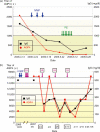Treatment of neuromyelitis optica: current debate
- PMID: 21180560
- PMCID: PMC3002541
- DOI: 10.1177/1756285608093978
Treatment of neuromyelitis optica: current debate
Abstract
Neuromyelitis optica (NMO) is an inflammatory demyelinating disease that largely affects optic nerves and spinal cord. Recent studies have identified an elevation of serum anti-aquaporin 4 antibody as a hallmark of NMO. Typical cases of NMO significantly differ from multiple sclerosis (MS) in immunological markers, histopathology, and responses to therapy. In fact, plasma exchange may be more efficacious for NMO than MS, whereas interferon-ß is recommended for MS but not for NMO. An emerging idea that pathogenesis of NMO may involve an interaction of the newly identified helper T cell subset, Th17, with B cells offers potential targets of therapy.
Keywords: Th17 cells; anti-aquaporin-4 antibody; interferon-β; multiple sclerosis; neuromyelitis optica.
Figures




References
-
- Acosta-Rodriguez E., Napolitani G., Lanzavecchia A., Sallusto F.(2007) Interleukin 1beta and 6 but not transforming growth factor-beta are essential for the differentiation of interleukin 17-producing human T helper cells. Nat Immunol 8: 942–949 - PubMed
-
- Allbutt T.(1870) On the ophthalmoscopic signs of spinal disease. Lancet 1: 76–78
-
- Baccala R., Kono D.H., Theofilopoulos A.N.(2005) Interferons as pathogenic effectors in autoimmunity. Immunol Rev 204: 9–26 - PubMed
-
- Bakker J., Metz L.(2004) Devic's neuromyelitis optica treated with intravenous gamma globulin (IVIG). Can J Neurol Sci 31: 265–267 - PubMed
LinkOut - more resources
Full Text Sources

